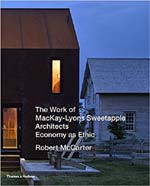
|

|
|
Home Site Search Contact Us Subscribe
|
|
Book Review: "The Work of MacKay-Lyons Sweetapple: Economy as Ethic": Transforming the local and commonplace into the global and rare Robert McCarter (with a little help from his friends) crafts a majestic survey long overdue. By Norman Weinstein May 25, 2017 Last year I joined the rare company of university educators globally who taught a survey course on Canadian architecture. Absurdly compressed into a weekend-long marathon of eight-hour-a-day lectures and film showings, much of the course has slipped from memory – except for one incident. Students – every single one! – voiced exuberant hosannas for the work of Brian MacKay-Lyons and Talbot Sweetapple. Damn. If only there had been a book about the firm to recommend to students then, some visionary future architects might have emerged from that whirlwind architectural survey. No student had the financial means to take a jaunt to Nova Scotia to experience this architecture first-hand. So a brief CBC film had to suffice.
Here is that penultimate book on Mac-Kay Lyons Sweetapple I wished had been around years ago. Let’s get superlatives out of the way. With The Work of MacKay-Lyons Sweetapple: Economy as Ethic, architectural historian Robert McCarter has done his most insightful writing ever, as if his previously published books about Kahn and Scarpa were warm-ups for this volume. The useful themes at the core of the MacKay-Lyons Sweetapple practice are framed lucidly. Three quarters of this comprehensive survey reflects the firm’s emphasis over three decades. Private homes in Atlantic Canada, and particularly around Nova Scotia, overwhelmingly dominate. Every house synthesizes in wood and glass lessons learned from the Atlantic Canada style of vernacular architecture. They’re designed for a tempestuous land and rural way of life that leaves its inhabitants as well as their homes well weathered.
And yet . . . this is a rural vernacular style centuries old, transfigured by the Modernism of Frank Lloyd Wright, Le Corbusier, and Louis Kahn. Each MacKay-Lyons Sweetapple house vitally commands a presence in a folk-driven past and a modern sustainable present. McCarter is perceptive in realizing how these houses are archetypal designs marked by clean functional lines that make them seem as rooted to the Nova Scotia landscape as the people residing there – while also functioning as comfortably livable architecture offering a dancing space for the lyrical light plays of nature.
Other cheers: the book production surpasses anything I’ve seen from a big-name publisher (Thames & Hudson, take a bow!) in years. Photography glows with telling details. The book’s heft offers the apt gravitas this firm deserves .The additional essays by Juhani Pallasma, Kenneth Frampton, MacKay-Lyons, and Sweetapple offer additional slants to McCarter’s authoritative text.
No architectural tourist trip planned to the rocky shores of Eastern Canada? No matter. This takes you thoughtfully there in spirit and imagination to critically reflect on one of the most original and creative architectural firms anywhere.
Norman Weinstein is the author of “Words That Build” – an exclusive 21-part ArchNewsNow.com series about writing as a keystone of a successful architectural practice. He's authored several books of poetry and books about music and literature. Weinstein is currently learning weaving in order to deepen his understanding of architecture, music, and poetry. He can be reached at nweinstein25@gmail.com..
More by Weinstein:
An exclusive 21-part series that focuses on the overlooked foundations of architecture: oral and written communication.
Weinstein: From Ada to Zaha and Everything In Between Op-eds, book reviews, musings, and debate.
|
(click on pictures to enlarge) 
|
© 2017 ArchNewsNow.com